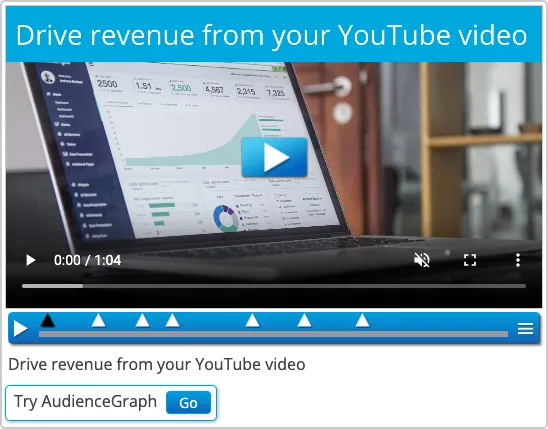Your Video Should Be a Dialog

Aug 03, 2023
Video today, and corporate content generally, is typically a monologue at an imagined audience. While understandable, this is not well aligned with the basic principle that sales result as much from listening as talking. And by basic, I mean that I have heard some version of that from pretty much every sales professional I have worked with.
So why should our video presentations be closer in spirit to “Come on down to Crazy Bob’s Car-O-Rama!” than to the past century of sales training and practice? It is time to quit screaming into the void.
- Passing Control to the Viewer
- How This Benefits Both of You
- The Design Process: How Concepts Become Products
Passing Control to the Viewer
Step one in creating dialogue is giving the viewer more control about how they experience your video. We used to see movies and TV as they were shown. Not anymore. We’ve already seen a shift from the older model with online video and streaming media.
But this is only a first step. Your content does not exist in some sort of vacuum. It only has the meaning the viewer gives it. So to make content more meaningful, you need to not only understand the viewer as a statistic, but actually allow them the ability to operate as an individual.
How This Benefits Both of You
The couch-potato model works for entertainment, but if you aren’t in that business, you need to create an engaged viewer from a passive consumer. The more you can get viewers to engage with you, the more likely they are to become customers. Again, this is more or less Sales 101.
Several companies, including Graph, Wistia, and Vidyard realized this. Interestingly, no two solutions so far have been very similar, which means we each saw different possibilities. A comparison and critique session is a bit beyond the scope of this article, but if you have an interest in design thinking, it may be worth your while to examine the similarities and differences among the various approaches each company has taken.
The Design Process: How Concepts Become Products
Now that the topic of design thinking has been raised, let’s zoom in briefly on how this is usually implemented in software products.
UX (user experience) design is how we move from general concepts to specific screens, controls, and actions. Like other kinds of product design, it is research-based and iterative. Both because that’s the way to have better ideas, and because early designs seldom pass user testing and review intact (oof!). And like any type of design, it is primarily centered around the viewpoint of users, not the designers or manufacturers. Typical UX work-products might include wireframes, flowcharts, and descriptions of every interface component in terms of functions and actions.
UI (user interface) design, is the part of the process in which the ideas developed at the UX stage turn into concrete interface elements. For example, at the UX level, a wireframe might show a control, like a button, as having three states: enabled, clicked, and disabled. UI designers are responsible for turning that into specific colors, sizes, shapes, sounds, typography, and so forth. Further, they need to create an organized and consistent visual syntax for each element that is shown to the user.
UI work-products might be things like color sets, icons, type specs, and animation examples, plus static and walkthrough mockups showing how these are implemented for each screen type and how they work in sequence. If the project has scope for it, a full design framework may be constructed, which can be used for other designs to maintain consistency.
Sometimes UX and UI design might be handled by one person. At other times, each set of tasks may have sizable teams involved.
AudienceGraph
At AudienceGraph, we made some decisions early on in the research and ideation phases that have carried through to the current product. A major one was realizing that the mechanic of video chapters had a lot of unrealized potential.
Each chapter is defined by a title topic and a timecode, i.e. what it’s about and where it begins in the video. Our underlying technology is, in fact, good at understanding topics conceptually, so that gave us a way to both help users locate and play the parts they were interested in (like the thirteen minutes of a one-hour webinar that you actually care about) and to then assist the user on that basis.

All of this is embodied in the “Blue Bar” found under any video that’s been wrapped with AudienceGraph. It includes chapter markers which can display topics, and if you jump to a chapter, any CTAs specifically associated with it are shown below the bar. CTAs can include offers to chat about a topic, purchase offers, or even expert consultation, for example.
This makes CTAs timely and relevant to the viewer, instead of making them hunt around, or wait until the end of the video. And one of the primary jobs of UX/UI design is to reduce the amount of thinking and action demanded of a user before they can accomplish their goal. It’s also why the Blue Bar is a persistent element, rather than a transient one: if you pick good topics and CTAs to show your viewer, the bar is always going to be valuable to them.
By engaging with your video with the Blue Bar, the viewer can enter into the sales process. They become an active participant in that process, not a target of it.
And that is how the dialogue starts.
Get Started Now
We built AudienceGraph, and it’s ready for you to start using now. Get started by using our Chapterlytics app for Chrome, or jump straight in here. You can add chapters to any standard web video even if your videos are hosted somewhere that doesn’t enable chapters natively. It’s easy to get started with AudienceGraph, and we think you’ll want to use it throughout your website once you see the benefits.
About GraphAI
GraphAI is creating the next generation of web pipeline generation for for growth, GTM and ABM teams. Explore the GraphAI platform and products from the menu above
Recent Posts
They're not following your customer journey!
Feb 25, 2025
Drive Engagement with Detailed Video Analytics
Jul 12, 2023
Being Smart About AI
Jul 11, 2023
Is Marketing Automation Up To The Challenge Of Video?
Jun 22, 2023
You Need Better Video Marketing Analytics
Jun 21, 2023

